Understanding ColdFusion
This chapter describes ColdFusion application pages, ColdFusion components, and how ColdFusion Server works with a Web server to deliver dynamic content to a browser.
Contents
-
ColdFusion Web Applications 8
-
CFML 10
-
ColdFusion Server 11
-
The ColdFusion Administrator 12
-
Development Considerations 13
ColdFusion Web Applications
ColdFusion Web applications are collections of pages that can contain XML, HTML, and other client technologies such as CSS and JavaScript.
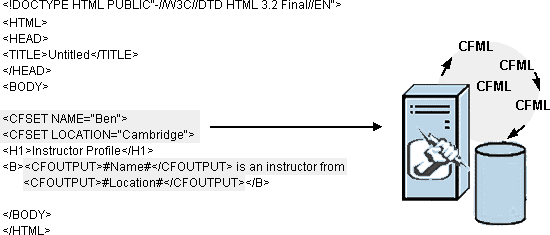
ColdFusion application pages are different from static HTML pages in the following ways:
-
They are saved and referenced with a specific file extension. The
default ColdFusion file extension is CFM.
-
They contain ColdFusion Markup Language.
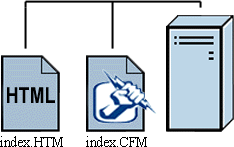
ColdFusion Enterprise and Professional Editions applications
Using ColdFusion Enterprise and Professional editions and ColdFusion Studio, you can build Web applications that leverage existing technologies and business systems such as RDMS, messaging servers, file repositories, directory servers, and distributed object middleware.

Note To learn about the full-featured ColdFusion development platform, refer to the http:/
/www.allaire.com/coldfusionColdFusion product pages.
ColdFusion Express applications
Using ColdFusion Express, you can build Web applications that interact with desktop databases that support the ODBC standard.
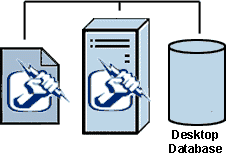
ColdFusion applications rely on these core development components:
-
The ColdFusion Markup Language (CFML)
-
ColdFusion Server
-
ColdFusion Administrator
CFML
CFML is a tag-based server scripting language that encapsulates complex processes such as connecting to databases and LDAP servers, and sending email. The core of the ColdFusion development platform language is more than 70 server-side tags and more than 140 functions.
ColdFusion Enterprise and Professional CFML
The CFML that’s delivered with the ColdFusion development platform is also extensible and seamlessly integrates with major distributed objects standards such as COM and CORBA.
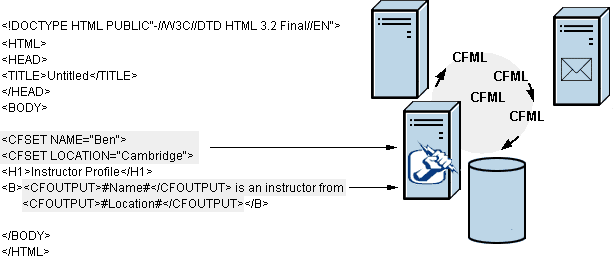
Note To learn about the full-featured ColdFusion development platform, refer to the http:/
/www.allaire.com/coldfusionColdFusion product pages.
ColdFusion Express CFML
ColdFusion Express CFML is a pared down server scripting language. ColdFusion Express CFML includes 10 server-side tags and a variety of functions that you can use to build Web applications that interact with databases that adhere to ODBC standards.

ColdFusion Server
Because CFML is a server-side scripting language, ColdFusion Server must be installed on a Web server to provide support for ColdFusion applications. The ColdFusion development platform provides a dynamic application environment that is both powerful and easy to use.
ColdFusion Enterprise and Professional Servers
ColdFusion Enterprise and Professional edition Servers:
-
Deliver a high-performance and scalable architecture.
-
Integrate with new and legacy technologies.
-
Provide a foundation for building secure applications.
Note To learn about ColdFusion Enterprise and Professional editions, refer to the http:// www.allaire.com/coldfusionColdFusion product pages.
ColdFusion Express Server
The ColdFusion Express Server is a pared down version of ColdFusion Server. It possesses the same engine as ColdFusion Server with fewer bells and whistles.
ColdFusion Express Server supports high performance and throughput through:
-
Database connection pooling
-
Just-in-time page compilation and caching
How ColdFusion Server works
Regardless of which ColdFusion Server you have installed, ColdFusion application pages are processed on the server at run-time - each time they are requested by a browser.
When any ColdFusion Server is installed on a Web server:
-
The Web server passes files to ColdFusion Server if a page request
contains a ColdFusion file extension.
-
ColdFusion Server scans the page and processes all CFML tags.
-
ColdFusion Server then returns only HTML and other client-side
technologies to the Web server and, in turn, the browser.
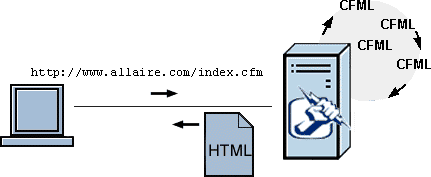
The ColdFusion Administrator
The ColdFusion Administrator is the browser-based interface for ColdFusion Server.
The ColdFusion Enterprise and Professional Administrator
You use it to fine-tune and configure the following for Enterprise and Professional edition ColdFusion Servers:
-
ODBC and native data sources that applications will use to connect
to databases
-
Settings and parameters for optimal server performance
-
Debugging display options for development testing
-
Security at the application level
-
Clusters when working in a multi-server environment
-
Scheduling for static page publishing
-
Server mappings for directories
ColdFusion Express Administrator
The Administrator for ColdFusion Express Server is a pared down version of the Administrator for ColdFusion Server. You will use it to fine-tune and configure the following settings for the ColdFusion Express Server:
-
ODBC data sources that applications will use to connect to databases
-
Settings and parameters for optimal server performance
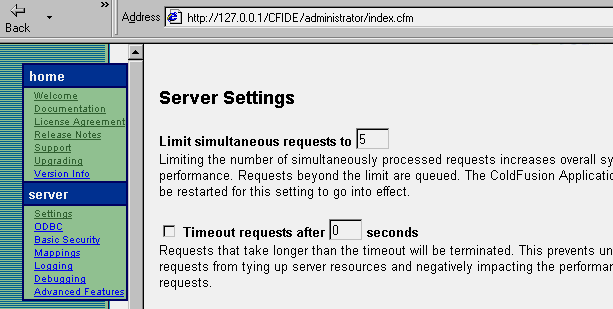
Development Considerations
This chapter introduced you to:
-
ColdFusion application pages
-
CFML
-
ColdFusion Server
-
ColdFusion Administrator
Where to go from here
-
Move on to the next chapter to verify your environment is set up for
development.
-
Move on to Chapter 3, “Understanding Development,” on page 21 for
more details about how to develop ColdFusion applications and to see for yourself how ColdFusion application pages are processed.
-
To learn about ColdFusion development platform components, refer to
the
http://www.allaire.com/coldfusionColdFusion product pages.
C HA PT ER 2
